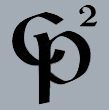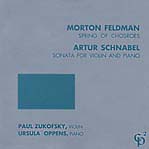MORTON FELDMAN
SPRING OF CHOSROES
The Spring of Chosroes was a sumptuous carpet reputed to have been made for the Sassanian King Chosroes I (sixth-century A.D.). Woven with silk, gold, silver and rare stones, the carpet depicted a garden akin to Paradise. The image of this legendary rug remained with Feldman throughout the composition, inspiring the isolated "gems" of sound, the translucent, interwoven harmonic timbres, and suggesting the form of thework.
From the onset, the Spring of Chosroes confronts us, not with the traditional violin/piano exchange, but with two separate yet integral monologues. The continuous repetition of the piano’s opening two chords forms a ground around which the disparate violin weaves an image of pizzicato sounds and bowed harmonics. Both the instruments’ dissimilar pacing and their harmonic and registral differences combine to produce the image of two separate lines moving parallel through time, but at moments these "uncompromising" instruments exchange like material. In these moments of self-conscious "détente," Feldman exposes the various degrees of their compatibility.
Feldman has taken these most complementary instruments and held each apart, examining one, then the other. It is Feldman’s ear which reveals the form — scanning as an eye would scan a carpet — first a close focus on one pattern, then on another; then a wide-angle view of two patterns at once. The nature of these instruments’ interaction becomes elusive. Even when one instrument plays alone, we do not get the customary impression that the other is waiting to reply. Rather, Feldman is choosing to turn an ear to one instrument, then to the other; and at times we hear both together. It is through this selective listening that Feldman paces the unfolding dialogue.
The violin and piano are held together by a tightly-knit pitch-world. Both their harmonic and melodic sound-palettes are constructed from three pitches a half-step apart (such as the violin’s opening D#, E, F) with the occasional harmonic coloring of the tritone and/or perfect intervals. Using the resultant dichotomy between the dissonant half-steps and the consonant perfect intervals, Feldman creates the parallel impression of distance and intimacy between the violin and piano.
Even though both instruments explore a full range of their technical possibilities,the listener is nevertheless left with the suggestion of two instruments quite immobilized, self-contained, and distant. The violin is constricted, breathless; always too short, too sad, too remote. Never is heard the full, exalted sound that the violin has immortalized; here a double-stopis the warmest sound. The piano has abandoned its traditional function of articulating or interpreting the action. This scenario succeeds because it is enacted on the same surface. Feldman has flattened the three-dimensional questions/answer exchange into two dimensions whose frozen imagery is suspended in an eerie equilibrium not unlike the figures of a Piero della Francesco fresco. The instruments have that same sober inner-life; one not exposed through the usual musical expressions, but explored through an allusive series of glances and innate gestures.
The Spring of Chosroes, a commission by the McKim Fund in the Library of Congress, was composed in 1977. It is dedicated to Paul Zukofsky, and was first performed by Paul Zukofsky and Ursula Oppens.
Bunita Marcus
ARTUR SCHNABEL
SONATA FOR VIOLIN AND PIANO
Artur Schnabel (1882-1951) is still, as in his lifetime, known principally as one of the great pianists of this century, and one of the foremost Beethoven interpreters ever. What is not so known is that he was also a very active composer, writing throughout his lifetime, and towards the end of his life, concentrating more on his composing than his concertizing. A list of his compositions includes three symphonies, two other orchestral works, five string quartets, various other solo and chamber works, and song cycles.
Despite the fact that Schnabel never performed contemporary music, his own musicis extremely modern and individualistic, and in my opinion greatly influenced his piano playing. The plasticity of phrase and timing that he is so known for in Beethoven is seen clearly in his compositional concerns, which led him to write totally unbarred music, as well as music of extreme rhythmical sophistication.
The Sonatafor Violin and Piano was written in 1935, and given its premiere in 1944. If I were to suggest a somewhat more familiar work that appears similar to me in many ways, it would be the Duo by Roger Sessions, dating from 1942. Indeed, Sessions talked to me quite lovingly about his regular luncheon meetings with Schnabel, during which time Roger would ask Schnabel’s advice about piano playing, and Schnabel would discuss composition with Sessions. For me, both works emerge out of a post First World War common European language that, while it never grew into a school or specific style, nevertheless produced various works of significant beauty, all too sadly ignored.
Among the many aspects of the Sonata that appeal to and fascinate me are: the incredible irregularity of phrase lengths, and the freedom of their succession; the counterpoint; the "polyrhythmic" (or perhaps better— poly-divided) second movement with non-stop 5 against 4, except when it is 6 against 5 against 4; the theatricality of the movement endings and sustained chords that no longer speak, whose duration is specified exactly; the rhythmic unfoldings of the third and fourth movements which create the impression of metric modulation; the humor and warmth of an altogether lovely piece of music.
Observant listeners will note that the opening piano phrase of the Schnabel is almost identical to a violin harmonics phrase that occurs towards the very endof the Feldman. I hasten to remark that Feldman had no prior knowledge of the Schnabel, although I have not been able to ascertain the reverse! In any event, this coincidence (if that is what it is) made it imperative in my mind that these two works be paired.
PZ
TRACK LISTING
|
MORTON FELDMAN
SPRING OF CHOSROES
|
| 1. Spring of Chosroes |
(17:32) |
| |
ARTUR SCHNABEL
SONATA FOR VIOLIN AND PIANO
|
| 2. Allegro ma non troppo (quasi moderato e sempre semplice) |
(8:56) |
| 3. Allegretto poco vivace |
(2:20) |
| 4. Adagio |
(7:36) |
| 5. Vivace |
(6:28) |
| |
Time = 25:20
TOTAL TIME = 43:23
|
Feldman: Spring of Chosroes and Schnabel: Sonata for Violin and Piano were recorded at the Library of Congress, May 11-12, 1979. Spring of Chosroes is published by Universal Edition, Ltd., and was commissioned by the McKim Fund of the Library of Congress which also assisted with this recording. The Schnabel Sonata for Violin and Piano is published by Boosey and Hawkes, Inc.
Recording Engineers: John Howell, Robert Carneal
Engineering Assistant: Michael Donaldson
Editor: Joanna Nickrenz (Elite Recordings, Inc.)
CP2102
© 1991 Musical Observations, Inc.
Warning: Copyright subsists in all recordings issued under this label.
|



